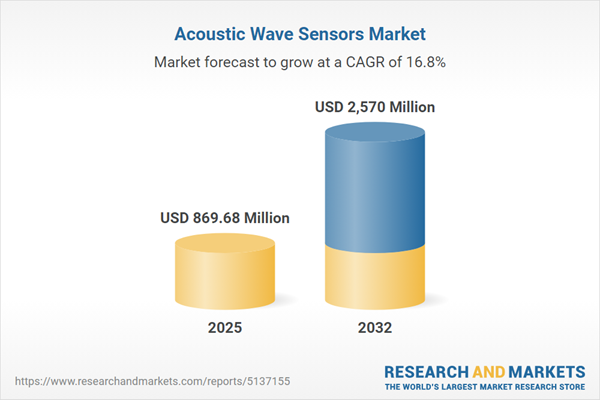Speak directly to the analyst to clarify any post sales queries you may have.
The acoustic wave sensors market demonstrates robust advancement, powered by cross-industry demand for high-precision, miniaturized sensor technologies suitable for emerging applications in automotive, environmental, healthcare, and industrial sectors. Increasing adoption, material innovations, and regulatory trends collectively shape a competitive yet dynamic landscape for decision-makers seeking measurable results.
Market Snapshot: Acoustic Wave Sensors Market Growth and Outlook
The Acoustic Wave Sensors Market grew from USD 743.26 million in 2024 to USD 869.68 million in 2025. It is expected to continue growing at a CAGR of 16.80%, reaching USD 2.57 billion by 2032. This upward trajectory is anchored by acoustic wave technology's ability to transform mechanical wave interactions into accurate, actionable signals, addressing intricate detection needs across major verticals. As innovative device architectures evolve, industries benefit from scalable, rapid, and highly sensitive sensing capabilities, ensuring a resilient supply outlook through regional diversification and technology collaborations.
Scope & Segmentation of the Acoustic Wave Sensors Market
- Device Types: Bulk acoustic wave sensors, solidly mounted resonators, thin film bulk acoustic resonators, quartz crystal microbalances with AT and BT cut variants, and surface acoustic wave devices, including Love wave, Rayleigh wave, and shear horizontal modes.
- Applications: Automotive in-vehicle and tire pressure monitoring, environmental air and water quality monitoring, food safety with pathogen detection and quality assurance, healthcare diagnostics for both laboratory and point-of-care, and industrial process control and predictive maintenance.
- Material Classes: Aluminum nitride, lithium niobate (X, Y, Z cuts), lithium tantalate (X, Y, Z cuts), natural and synthetic quartz, zinc oxide.
- Regional Markets: Americas (United States, Canada, Mexico, Brazil, Argentina, Chile, Colombia, Peru), Europe, Middle East & Africa (United Kingdom, Germany, France, Russia, Italy, Spain, Netherlands, Sweden, Poland, Switzerland, United Arab Emirates, Saudi Arabia, Qatar, Turkey, Israel, South Africa, Nigeria, Egypt, Kenya), Asia-Pacific (China, India, Japan, Australia, South Korea, Indonesia, Thailand, Malaysia, Singapore, Taiwan).
- Leading Companies: Abracon LLC, ALTANOVA GROUP, Althen Gmbh, Boston Piezo-Optics Inc., Christian Bürkert GmbH & Co. KG, COMSOL AB, CTS Corporation, Electronic Sensor Technology Inc., Endress+Hauser Flow AG, General Electric Company, H. Heinz Meßwiderstände Gmbh, Hawk Measurement Systems, Honeywell International Inc., KYOCERA AVX Components Corporation, Microchip Technology Inc., Murata Manufacturing Co., Ltd.
Key Takeaways for Senior Decision-Makers
- Acoustic wave sensors deliver a unique blend of speed, precision, and operational resilience, ensuring suitability for demanding real-time monitoring applications in automotive, healthcare, and industrial automation.
- Advancements in piezoelectric films and sensor miniaturization enable integration into next-generation portable diagnostic devices and smart industrial systems, supporting both performance and scalability.
- Improved signal processing, including the adaptation of machine learning algorithms, heightens sensor data interpretation for accurate anomaly detection and predictive analytics, fostering smarter maintenance and diagnostics strategies.
- Cross-industry partnerships, particularly with semiconductor fabs and integrators, accelerate commercialization cycles and expand acoustic wave sensor deployment in high-growth segments such as food safety and environmental stewardship.
- Material innovation, including the development of new electrode cuts and substrate compositions, enhances system stability, reduces manufacturing cost, and supports transition toward broader Internet of Things (IoT) and wireless connectivity use cases.
Impact of U.S. Tariffs on Supply Chain and Innovation Trajectory
Recent United States tariffs have introduced notable pressure on global supply chains for acoustic wave sensors, elevating costs for key piezoelectric substrates and packaging components. In response, manufacturers actively diversify sourcing strategies and evaluate regional production to lower exposure. This transition fuels the exploration of localized manufacturing hubs and co-manufacturing ventures that mitigate both procurement complexity and regulatory risk, while encouraging material efficiency and modularity in product design.
Methodology & Data Sources
This research draws on comprehensive primary interviews with manufacturing executives, system integrators, and end-user organizations, enhanced by extensive secondary analysis of technical literature, patents, industry reports, regulatory documentation, and market data. All conclusions reflect rigorous internal validation.
Why This Report Matters for Executive Planning
- Enables actionable, risk-mitigated investments by illuminating evolving supplier strategies, regulatory shifts, and technology trends specific to acoustic wave sensors.
- Facilitates confident portfolio development with segment-level insights into device adoption patterns, material science breakthroughs, and regional innovation ecosystems.
- Delivers a cohesive overview ideal for sourcing, R&D, or compliance leaders pursuing optimal sourcing, collaboration, and go-to-market strategies in a rapidly changing sensor market.
Conclusion
Acoustic wave sensors are cementing their position as a foundational technology across multiple sectors. Firms that align material innovation, regulatory compliance, and ecosystem collaboration are best placed to capitalize on future market opportunities and maintain resilience.
Additional Product Information:
- Purchase of this report includes 1 year online access with quarterly updates.
- This report can be updated on request. Please contact our Customer Experience team using the Ask a Question widget on our website.
Table of Contents
3. Executive Summary
4. Market Overview
7. Cumulative Impact of Artificial Intelligence 2025
Companies Mentioned
The companies profiled in this Acoustic Wave Sensors market report include:- Abracon LLC
- ALTANOVA GROUP
- Althen Gmbh
- Boston Piezo-Optics Inc.
- Christian Bürkert GmbH & Co. KG
- COMSOL AB
- CTS Corporation
- Electronic Sensor Technology Inc.
- Endress+Hauser Flow AG
- General Electric Company
- H. Heinz Meßwiderstände Gmbh
- Hawk Measurement Systems
- Honeywell International Inc.
- KYOCERA AVX Components Corporation
- Microchip Technology Inc.
- Murata Manufacturing Co., Ltd.
Table Information
| Report Attribute | Details |
|---|---|
| No. of Pages | 186 |
| Published | November 2025 |
| Forecast Period | 2025 - 2032 |
| Estimated Market Value ( USD | $ 869.68 Million |
| Forecasted Market Value ( USD | $ 2570 Million |
| Compound Annual Growth Rate | 16.8% |
| Regions Covered | Global |
| No. of Companies Mentioned | 17 |









